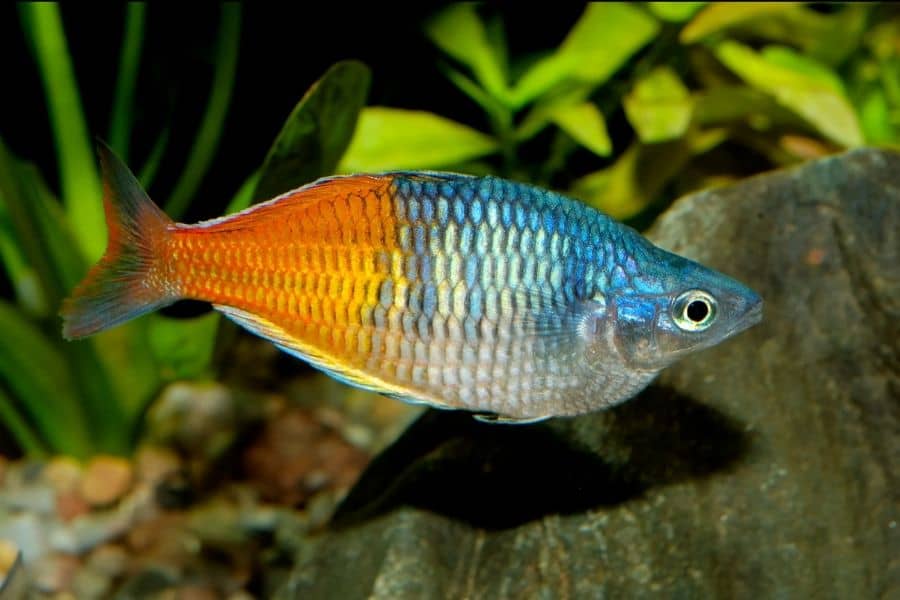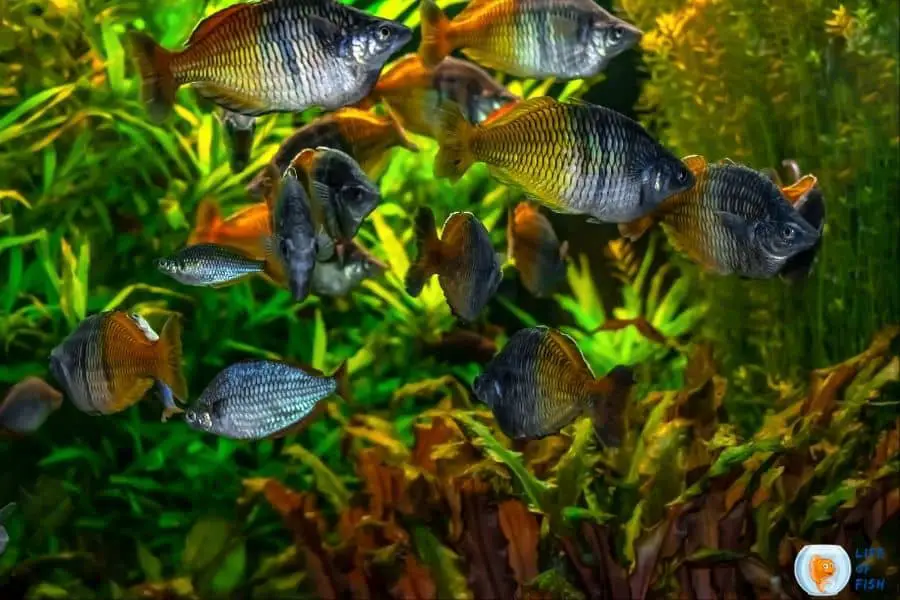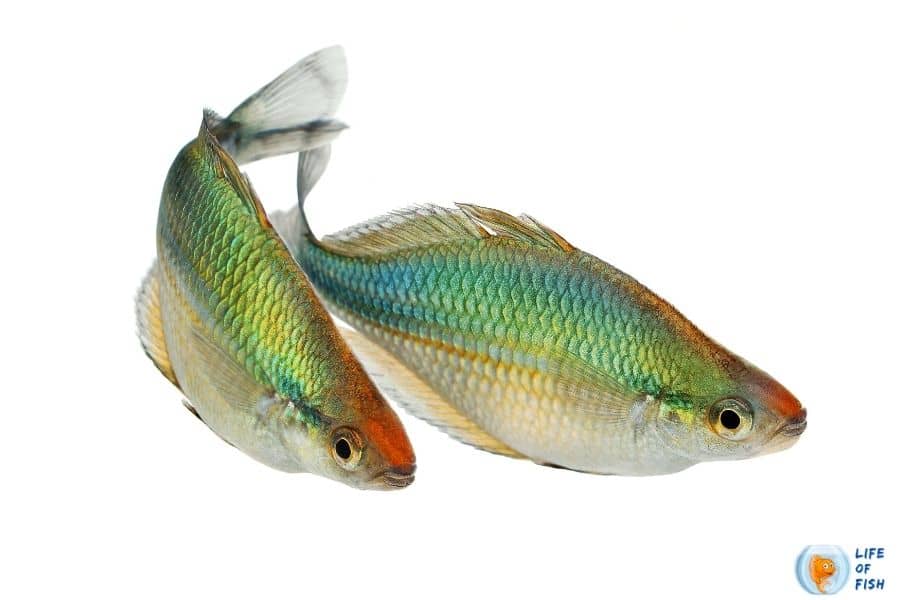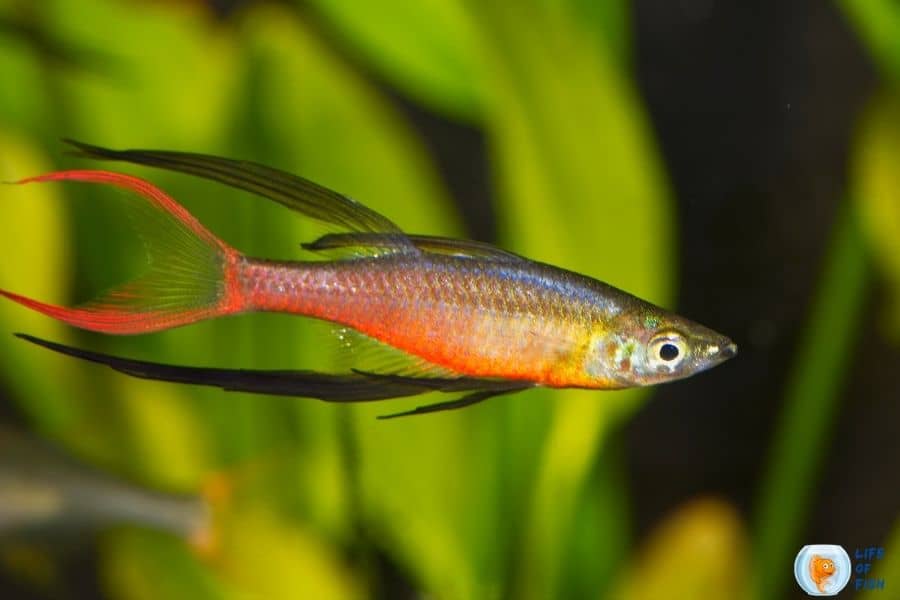Rainbowfish are omnivore fish species that eat both meat and plants. So, naturally, rainbowfish eat plants but, they cannot hurt the plants so badly because of their tiny mouths.
Therefore, they mostly eat only soft-leaved plants. Rainbowfish do like a lot of plant-based food in their diet.
If they don’t get enough plant based food, they would probably go for aquarium plants.

What type of plants are eaten by rainbowfish?
Jump To
- 1 What type of plants are eaten by rainbowfish?
- 2 How to prevent rainbowfish from eating plants
- 3 Do rainbowfish need plants?
- 4 What plants do rainbowfish like?
- 5 Best Plants for RainbowFish Aquariums
- 6 Do rainbowfish eat algae?
- 7 Do rainbowfish eat algae wafers?
- 8 What do rainbowfish eat in the wild?
- 9 How fast do rainbowfish grow?
- 10 Summary
Because of Rainbowfish‘s small mouths, they cannot eat hard-leaved plants. Rainbowfish mostly look for soft-leaved plants to eat.
They also prefer food that floats on the surface. Further, rainbowfish are middle dwellers.
So, rainbowfish will mostly eat plants that float and grow in the middle of the tank. Some plants rainbowfish will eat are,
- Stargrass
- Glosso
- Tonina fluviatillis
- Elatine Americana
- Hygro polyspherma
- Duckweed
- Hygrophila corymbosa compacta
Although many rainbowfish eat plants, some rainbowfish don’t eat plants at all.
Just like humans, each rainbowfish has a different personality. Some rainbowfish accept only the food that you offer and don’t bother eating plants.
However, if rainbowfish in your tank eat plants, then there is no way to turn them back because once they start to eat plants, they will keep doing it regardless of how much you will feed.
How to prevent rainbowfish from eating plants
To prevent rainbowfish from eating plants, you should feed them well with a balanced diet.
Although rainbowfish are omnivore species, they prefer more plant based food in their diet.
So, do feed them with food like peas, lettuce, cucumber, and veggie flakes. Preventing can be done for only the fish that still didn’t eat any plant matter.
If your fish are already eating plants, then it is not possible to reverse their habit.
If that is what you experience, you will either have to remove your Rainbowfish from the planted tank or replace your plants with hard-leaved plants or bitter taste plants in your aquarium.
Another solution is to replace your plants with fast-growing plants like hornwort.

Do rainbowfish need plants?
No. Rainbowfish don’t necessarily need plants to thrive.
Rainbowfish are very active middle-dwelling fish that need lots of space to explore. They can survive without plants in aquariums as long as you feed them well.
However, you should provide plenty of hiding spaces like artificial plants, driftwood, caves, and rocks.
If Rainbowfish don’t get any places to hide, things get stressful for them.
If you intend to breed Rainbowfish, you must also provide suitable hiding places for the fish fry. Any fine-leaved aquatic plants like Java moss and Christmas moss are ideal for this.
Other than that, Rainbowfish can live without plants, given that they get a balanced diet.
What plants do rainbowfish like?
In the wild, rainbowfish eat anything they can find, including plants. They mainly eat plants and algae because they like vegetation.
This habit doesn’t change even though these fish are captive-bred. Rainbowfish will eat any plant they find in captivity if the plant is not bitter tasting or tough.
Some known plants that Rainbowfish like to eat are,
- Sagataria
- Duckweed
- Hygrophila corymbosa stricta
- Hygrophila
- Cabomba
- Egeria densa
- Aponogeton
- Rotala
- Myriophyllum
- Nymphaea lotus
- Water sprite
Keep in mind that Rainbowfish will eat any plant they could find if the fish you own like vegetation.
We have heard that some rainbowfish even eat bitter taste plants like java fern and hard-leaved plants like anubias.
However, that depends on each fish’s personality because some fish like to eat plants while others don’t. If you got a rainbowfish that doesn’t eat plants, you are so lucky.
Try to keep that fish in that way by feeding it well so that you can keep your plants safe and sound.

Best Plants for RainbowFish Aquariums
Rainbowfish likes all types of plants except plants that have a bitter taste.
They even nibble on hard-leaved plants like anubias, although they can not eat them because of their mouth.
They prefer planted aquariums because they get shelter, food, and hiding places from plants. However, if you want to save plants from Rainbowfish, you will have to grow hard-leaved plants and bitter taste plants in your aquarium.
Some suitable plants for rainbowfish aquariums are,
Anubias
Anubias is a genus of plants that is semi-aquatic and beginner-friendly.
This is a slow-growing plant that does not require high nutrient levels or CO2 injection. Therefore these plants are suitable for low-tech aquascaping.
Anubias leaves are very tough and have an odd taste that fish hates. So, it can withstand most herbivorous fish. Rainbowfish don’t eat this plant mainly because of its hardness.
Java fern
Java fern is one of the most well-known aquatic plants in the aquarium trade because of its aesthetic look.
They are remarkably easy to care for, making them ideal for beginners. You can grow this plant fully or partially submerged according to your choice, and it will grow in either dim light or bright light.
The specialty of this plant is that many herbivorous species avoid eating this plant because of its bitter taste.
The leaves of java fern are also stiff that fish can not nip easily. Many aquarists that have plant-eaters choose this plant because of these reasons.
Crypts
Crypts or scientifically known as Cryptocoryne genus, is a hardy plant that can thrive on even hardy water, making it suitable for beginners.
These plant varieties are famous because of their colorful leaves that range from deep forest green to pale green, olive, mahogany, and pink.
What makes it stand out from herbivorous fish species is the hardness of its leaves. Plant-eating fish leave this plant from eating because of its stiff leaves.
Amazon Swords
These plants are inexpensive but very popular plants in the aquarium trade because of their bladelike appearance and impressive endurance.
Also they are the go-to plant for any tank set up in any water conditions within many aquarists. Another reason for aquarists to use this plant is that fish avoid eating Amazon swords.
Its leaves and stem are generally too tough for herbivorous fish to eat. Therefore, Amazon swords withstand plant-eating fish.
Bacopa caroliniana
This is an undemanding plant in the aquarium trade. Bacopa caroliniana is suitable for any kind of plant setup because it is easy to care for, adaptable, tolerable, and has a sturdy structure.
Also known as lemon bacopa, this plant can withstand herbivorous fish species because of its taste.
Bacopa has a very strong flavor that plant-eating fish hate. Even fish that breed to control aquatic plants’ overgrowth, like triploid grass carp, avoid eating this plant because of its taste.
Egeria najas
Egeria najas is an anacharis species that is not yet familiar in the aquarium hobby. It is a submerged plant that has a delicate appearance, adaptable and fast-growing.
This plant is a perfect hiding place for the fish fry, but fish that don’t eat this plant maybe because of its taste.
However, eating this plant won’t harm the fish, so you don’t have to worry if your fish eat this plant.
Hornwort
Hornwort is one of the easiest aquatic plants you can grow as it has a high tolerance to various water conditions.
Further, hornwort is fast-growing and easy to propagate, making it ideal for beginners. Herbivorous fish actually eat this plant.
But not to the extent that they harm the plant. Although your fish graze this plant all day long, they can not finish off the whole plant because of its fast growth rate.
This nature is helpful in aquariums as you can provide a natural food source for your herbivorous fish without emptying your pocket, but it is not suitable for the wild because it is an invasive species.

Do rainbowfish eat algae?
Yes, Rainbowfish are omnivore species that love to eat plant matter. So, they eat algae naturally.
Rainbowfish feed mainly on plants and algae in the wild and also eat small insects, tadpoles, crustaceans, and really small fish.
This habit naturally comes to captive-bred fish too.
Do rainbowfish eat algae wafers?
Yes. Rainbowfish eat algae wafers.
Since Rainbowfish eat any plant matter, including algae, rainbowfish like to eat algae wafers.
What do rainbowfish eat in the wild?
Rainbowfish are omnivore fish that eat anything they could find in the wild.
In their native waters, Rainbowfish mainly eat algae and plants. They also eat live food like aquatic insects, terrestrial insects, tadpoles, crustaceans, and tiny fish.
However, the majority of their diet consists of algae in the wild.
How fast do rainbowfish grow?
There are several rainbowfish species in several sizes. Some species measure less than 2.4 inches long, while some species reach up to 7.9 inches.
Because of this species variation, it is not possible to estimate a growth rate commonly.
However, it takes around two years for all rainbowfish species to be fully grown.
As a typical rainbowfish lifespan is about 5 to 8 years, we can estimate that they take around ¼ time of their life to grow.

Summary
Rainbowfish are omnivorous fish species that eat both meat matter and plant matter. So, naturally, they eat plants and algae.
Rainbowfish actually love to eat more vegetation. Therefore, they will eat any plant that is reachable for them.
Although Rainbowfish eat plants, there are some rainbowfish that don’t eat plants. This behavior change is because each fish has a different personality, just like humans.
So, if you have Rainbowfish that do not eat plants, consider yourself lucky and feed them well with a balanced diet to prevent them from eating plants.
If your Rainbowfish are already eating plants, there is no way to reverse their habit. You can try replacing your plants with hard leaved plants like anubias and bitter taste plants like java fern for this type of fish.
Read Next: Assassin Snails Breeding Guide | 8 Interesting Facts To Know
